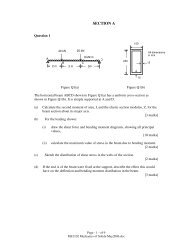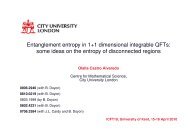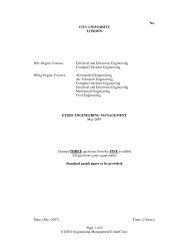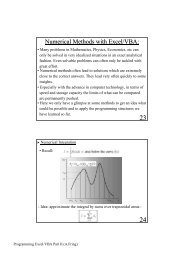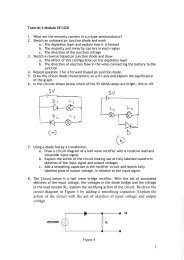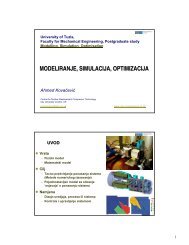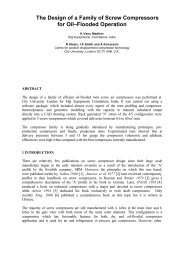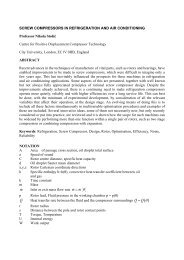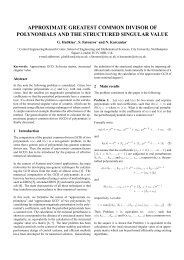Stochastic Modelling Solutions to Exercises on Time Series∗
Stochastic Modelling Solutions to Exercises on Time Series∗
Stochastic Modelling Solutions to Exercises on Time Series∗
You also want an ePaper? Increase the reach of your titles
YUMPU automatically turns print PDFs into web optimized ePapers that Google loves.
<str<strong>on</strong>g>S<str<strong>on</strong>g>to</str<strong>on</strong>g>chastic</str<strong>on</strong>g> <str<strong>on</strong>g>Modelling</str<strong>on</strong>g><br />
<str<strong>on</strong>g>Soluti<strong>on</strong>s</str<strong>on</strong>g> <str<strong>on</strong>g>to</str<strong>on</strong>g> <str<strong>on</strong>g>Exercises</str<strong>on</strong>g> <strong>on</strong> <strong>Time</strong> Series ∗<br />
Dr. Iqbal Owadally †<br />
March 3, 2003<br />
<str<strong>on</strong>g>Soluti<strong>on</strong>s</str<strong>on</strong>g> <str<strong>on</strong>g>to</str<strong>on</strong>g> Elementary Problems<br />
Q1. (i) (1 − 0.5B)X t = Z t . The characteristic equati<strong>on</strong> 1 − 0.5z = 0 does not have a unit<br />
root and the time series is ARIMA(1, 0, 0). The root of the characteristic equati<strong>on</strong><br />
is 2. Since |2| > 1, the time series is stati<strong>on</strong>ary. It is also (trivially) invertible.<br />
(ii) (1−0.5B)X t = (1−1.3B+0.4B 2 )Z t = (1−0.8B)(1−0.5B)Z t . Equati<strong>on</strong> 1−0.5z = 0<br />
does not have a unit root and the time series is ARIMA(1, 0, 2). The root of the<br />
characteristic equati<strong>on</strong> is 2. Since |2| > 1, the time series is stati<strong>on</strong>ary. The roots<br />
of equati<strong>on</strong> (1 − 0.8z)(1 − 0.5z) = 0 are 1.25 and 2. Since |1.25| > 2 and |2| > 1,<br />
the time series is invertible.<br />
(iii) (1 − 1.5B + 0.6B 2 )X t = Z t . The characteristic equati<strong>on</strong> does not have a unit root<br />
and the time series is ARIMA(2, 0, 0). The roots of the c.e. are (15 ± i √ 15)/12.<br />
Since |(15 ± i √ 15)/12| = (15 2 + 15)/12 2 = 5/3 > 1, the time series is stati<strong>on</strong>ary.<br />
It is also (trivially) invertible.<br />
(iv) “0.2” causes <strong>on</strong>ly a translati<strong>on</strong> of the mean level of the process and may be ignored<br />
here: let Y t = X t − 0.2 and represent the time series as (1 − B)(1 − 0.2B)Y t =<br />
(1−0.5B)Z t . The characteristic equati<strong>on</strong> does have a unit root and the time series<br />
is ARIMA(1, 1, 1). The time series is n<strong>on</strong>-stati<strong>on</strong>ary (being an I(1) process) but<br />
is invertible (the root of 1 − 0.5z = 0 being greater than 1 in magnitude).<br />
Q2. These processes are stati<strong>on</strong>ary: EX t and VarX t are c<strong>on</strong>stant and Cov [X t , X t−k ] depends<br />
<strong>on</strong> k and not <strong>on</strong> t.<br />
(i) EX t + 0.5EX t−1 − 0.1EX t−2 = EZ t = 0 and hence EX t = 0 ∀ t and ρ k = ρ −k =<br />
E [X t X t−k ] /VarX t . Furthermore, Z t is independent of X t−k for k ≥ 1, so that<br />
E [Z t X t−k ] = EZ t EX t−k = 0.<br />
Multiplying across X t + 0.5X t−1 − 0.1X t−2 = Z t by X t−k for k ≥ 1 gives<br />
X t X t−k + 0.5X t−1 X t−k − 0.1X t−2 X t−k = Z t X t−k .<br />
∗ <str<strong>on</strong>g>Soluti<strong>on</strong>s</str<strong>on</strong>g> <str<strong>on</strong>g>to</str<strong>on</strong>g> past exam questi<strong>on</strong>s are adapted from examiners’ reports <str<strong>on</strong>g>to</str<strong>on</strong>g> the Exam Board of the Institute<br />
and Faculty of Actuaries and <str<strong>on</strong>g>to</str<strong>on</strong>g> the Exam Board, Faculty of Actuarial Science and Statistics, Cass Business<br />
School, City University.<br />
† C<strong>on</strong>tact details: Cass Building Room 5071, extensi<strong>on</strong> 8478, iqbal@city.ac.uk.<br />
1
Taking expectati<strong>on</strong> <strong>on</strong> both sides yields<br />
E [X t X t−k ] + 0.5E [X t−1 X t−k ] − 0.1E [X t−2 X t−k ] = 0<br />
and dividing by VarX t <strong>on</strong> both sides gives ρ k + 0.5ρ k−1 − 0.1ρ k−2 = 0.<br />
When k = 1, ρ 1 + 0.5ρ 0 − 0.1ρ 1 = 0 which solves <str<strong>on</strong>g>to</str<strong>on</strong>g> ρ 1 = −0.5/0.9 = −5/9<br />
(noting that ρ k = ρ −k and ρ 0 = 1 by definiti<strong>on</strong>).<br />
When k = 2, ρ 2 + 0.5ρ 1 − 0.1ρ 0 = 0 yielding ρ 2 = 0.1 − 0.5(−5/9) = 17/45.<br />
When k = 3, ρ 3 +0.5ρ 2 −0.1ρ 1 = 0 yielding ρ 3 = 0.1(−5/9)−0.5(17/45) = −11/45.<br />
(ii) {X t } in X t + 0.6X t−2 = Z t will clearly have zero au<str<strong>on</strong>g>to</str<strong>on</strong>g>correlati<strong>on</strong> at odd lags.<br />
ρ k + 0.6ρ k−2 = 0 for k ≥ 1.<br />
When k = 1, ρ 1 + 0.6ρ 1 = 0 and ρ 1 = 0.<br />
When k = 2, ρ 2 + 0.6ρ 0 = 0 and ρ 2 = −0.6.<br />
When k = 3, ρ 3 + 0.6ρ 1 = 0 and ρ 3 = 0.<br />
(iii) ρ k − 1.1ρ k−1 + 0.18ρ k−2 = 0 for k ≥ 1.<br />
When k = 1, ρ 1 − 1.1ρ 0 + 0.18ρ 1 = 0 and ρ 1 = 1.1/1.18 = 55/59.<br />
When k = 2, ρ 2 − 1.1ρ 1 + 0.18ρ 0 = 0 and ρ 2 = 1.1(55/59) − 0.18 = 1247/1475.<br />
When k = 3, ρ 3 − 1.1ρ 2 + 0.18ρ 1 = 0 and ρ 3 = 1.1(1247/1475) − 0.18(55/59) =<br />
5621/7375.<br />
(iv) ρ k + αρ k−1 + α 2 ρ k−2 + α 3 ρ k−3 = 0 for k ≥ 1.<br />
When k = 1, ρ 1 (1 + α 2 ) + α + α 3 ρ 2 = 0.<br />
When k = 2, ρ 1 (α + α 3 ) + α 2 + ρ 2 = 0.<br />
(Note in the above that ρ 0 = 1 and ρ k = ρ −k ).<br />
Hence ρ 1 = −α/(1 + α 2 ) and ρ 2 = 0.<br />
When k = 3, ρ 3 + αρ 2 + α 2 ρ 1 + α 3 ρ 0 = 0.<br />
Hence, ρ 3 = −α 5 /(1 + α 2 ).<br />
Q3. (i) Y t = Z t − βZ t−1 .<br />
VarY t = VarZ t + β 2 VarZ t−1 = σ 2 Z (1 + β2 ).<br />
Cov [Y t , Y t−1 ] = Cov [Z t − βZ t−1 , Z t−1 − βZ t−2 ] = −βσ 2 Z .<br />
Cov [Y t , Y t−k ] = 0 for k ≥ 2.<br />
Since ρ k = γ k /γ 0 , ρ 1 = −β/(1 + β 2 ) and ρ k = 0 for k ≥ 2.<br />
(ii) Y t = Z t + 2.4Z t−1 + 0.8Z t−2 .<br />
VarY t = σ 2 Z (1 + 2.42 + 0.8 2 ) = 7.4σ 2 Z .<br />
Cov [Y t , Y t−1 ] = Cov [Z t + 2.4Z t−1 + 0.8Z t−2 , Z t + 2.4Z t−1 + 0.8Z t−2 ] = (2.4+0.8×<br />
2.4)σ 2 Z = 7.4σ2 Z .<br />
Cov [Y t , Y t−2 ] = 0.8σ 2 Z .<br />
Cov [Y t , Y t−k ] = 0 for k ≥ 3.<br />
Since ρ k = γ k /γ 0 , ρ 1 = 4.32/7.4 = 0.5838, ρ 2 = 0.8/7.4 = 0.1081 and ρ k = 0 for<br />
k ≥ 3.<br />
Q4. (i) The correlogram is a plot of au<str<strong>on</strong>g>to</str<strong>on</strong>g>correlati<strong>on</strong> functi<strong>on</strong> against lag, i.e. ρ k vs. |k|. An<br />
MA(q) process has a correlogram with a cu<str<strong>on</strong>g>to</str<strong>on</strong>g>ff at lag q, whereas a stati<strong>on</strong>ary AR<br />
process has a correlogram that tapers off gradually (possibly with some damped<br />
oscillati<strong>on</strong>s) <str<strong>on</strong>g>to</str<strong>on</strong>g> zero as the lag increases.<br />
Comments. Plotting the correlogram is therefore a way of distinguishing MA from<br />
AR time series, although in practice estimati<strong>on</strong> errors may mean that it is not so<br />
easy <str<strong>on</strong>g>to</str<strong>on</strong>g> discern a difference.<br />
2
(ii) The process is assumed <str<strong>on</strong>g>to</str<strong>on</strong>g> be stati<strong>on</strong>ary and we can proceed <str<strong>on</strong>g>to</str<strong>on</strong>g> find the au<str<strong>on</strong>g>to</str<strong>on</strong>g>correlati<strong>on</strong><br />
functi<strong>on</strong> by using the usual method for stati<strong>on</strong>ary time series. The time<br />
series is shifted by µ and EX t = µ ∀ t. Let Y t = X t − µ. Then, EY t = 0 ∀ t.<br />
The au<str<strong>on</strong>g>to</str<strong>on</strong>g>covariance functi<strong>on</strong> is γ k = Cov [X t , X t−k ] = Cov [Y t , Y t−k ] = E[Y t Y t−k ].<br />
Recall that γ k = γ −k . Also, EZ t = 0 and VarZ t = σ 2 Z ∀ t.<br />
Multiply Y t − αY t−1 = Z t − βZ t−1 by Y t−k <strong>on</strong> both sides and take expectati<strong>on</strong>s<br />
<str<strong>on</strong>g>to</str<strong>on</strong>g> obtain γ k − αγ k−1 = E[Y t−k Z t ] − βE[Y t−k Z t−1 ]. Observe that Z t is statistically<br />
independent of Y t−k , k ≥ 1. Therefore,<br />
when k = 0, γ 0 − αγ 1 = E[Y t Z t ] − βE[Y t Z t−1 ], (1)<br />
when k = 1, γ 1 − αγ 0 = −βE[Y t Z t−1 ], (2)<br />
when k > 1, γ k − αγ k−1 = 0. (3)<br />
The n<strong>on</strong>-zero cross-correlati<strong>on</strong>s involving Y t and Z t are easily found. Multiply<br />
Y t − αY t−1 = Z t − βZ t−1 by Z t <strong>on</strong> both sides and take expectati<strong>on</strong>s <str<strong>on</strong>g>to</str<strong>on</strong>g> obtain<br />
E[Y t Z t ] = σZ 2 ∀ t, noting that {Z t} is a sequence of independent and identically<br />
distributed random variables. Also, multiply Y t − αY t−1 = Z t − βZ t−1 by Z t−1<br />
<strong>on</strong> both sides and take expectati<strong>on</strong>s <str<strong>on</strong>g>to</str<strong>on</strong>g> obtain E[Y t Z t−1 ] − αE[Y t−1 Z t−1 ] = −βσZ 2 .<br />
Hence, E[Y t Z t−1 ] = σZ 2 (α − β).<br />
Equati<strong>on</strong> (1) may be simplified <str<strong>on</strong>g>to</str<strong>on</strong>g> γ 0 − αγ 1 = σZ 2 [1 − αβ + β2 ] and equati<strong>on</strong> (2)<br />
simplifies <str<strong>on</strong>g>to</str<strong>on</strong>g> γ 1 − αγ 0 = −βσZ 2 . Solving these two equati<strong>on</strong>s simultaneously yields:<br />
γ 0 = σ2 Z (1 − 2αβ + β2 )<br />
1 − α 2 , γ 1 = σ2 Z<br />
(α − β)(1 − αβ)<br />
1 − α 2 .<br />
Finally, equati<strong>on</strong> (3) solves <str<strong>on</strong>g>to</str<strong>on</strong>g> γ k = α k−1 γ 1 , for k > 1.<br />
Since ρ k = γ k /γ 0 by definiti<strong>on</strong>,<br />
⎧<br />
⎪⎨ 1 k = 0<br />
ρ k = (α − β)(1 − αβ)/(1 − 2αβ + β<br />
⎪⎩<br />
2 ) k = 1<br />
α k−1 ρ 1 k > 1.<br />
(iii) The correlogram of the ARMA(1, 1) time series has a ‘kink’ at lag 1. At lag 1,<br />
both the MA and AR comp<strong>on</strong>ents affect the correlogram. From lag 2 <strong>on</strong>wards, it<br />
looks rather like the correlogram of an AR series and it decays exp<strong>on</strong>entially.<br />
Q5. Comments. If the process were known (or assumed) <str<strong>on</strong>g>to</str<strong>on</strong>g> be stati<strong>on</strong>ary over time, then<br />
EX t = 0 and ρ k = 0.4 |k| , using the properties of a stati<strong>on</strong>ary AR(1) process. But<br />
the process has a finite his<str<strong>on</strong>g>to</str<strong>on</strong>g>ry (with a given initial c<strong>on</strong>diti<strong>on</strong>) and so it will be n<strong>on</strong>stati<strong>on</strong>ary<br />
for t < ∞.<br />
Soluti<strong>on</strong>.<br />
(i) In terms of the backward shift opera<str<strong>on</strong>g>to</str<strong>on</strong>g>r,<br />
X t = Z t /(1 − 0.4B) = Z t + 0.4Z t−1 + 0.4 2 Z t−2 + · · ·<br />
3
The process is arbitrarily started at t = 0 with X 0 = x 0 and X j = 0 for j ≤ −1.<br />
Hence, Z 0 = x 0 and Z j = 0 for j ≤ −1. Therefore,<br />
∑t−1<br />
X t = 0.4 j Z t−j + x 0 0.4 t .<br />
j=0<br />
{Z t } is a sequence of zero-mean random variables. Hence, EX t = x 0 0.4 t for t ≥ 0.<br />
(ii) Note that<br />
and that<br />
and also that<br />
X t+k − EX t+k =<br />
∑t−1<br />
X t − EX t = 0.4 j Z t−j<br />
t+k−1<br />
∑<br />
j=0<br />
j=0<br />
0.4 j Z t+k−j =<br />
∑t−1<br />
j=−k<br />
0.4 j+k Z t−j<br />
Cov [X t , X t+k ] = E {(X t − EX t )(X t+k − EX t+k )} .<br />
For k ≥ 0,<br />
⎧<br />
⎨∑t−1<br />
Cov [X t , X t+k ] = E 0.4 j Z<br />
⎩<br />
t−j ×<br />
j=0<br />
∑t−1<br />
j=−k<br />
⎫<br />
⎬<br />
0.4 j+k Z t−j<br />
⎭ = ∑t−1<br />
σ2 Z 0.4 j 0.4 j+k<br />
(where σZ<br />
2 = VarZ t) because {Z t } is a sequence of zero-mean independent and<br />
identically distributed random variables. Hence,<br />
for k ≥ 0 and t ≥ 0.<br />
Cov [X t , X t+k ] = σ 2 Z0.4 k (1 − 0.4 2t )/(1 − 0.4 2 ) (4)<br />
(iii) The process is not stati<strong>on</strong>ary for t < ∞ as both EX t and Cov [X t , X t+k ] vary<br />
with t.<br />
(iv) The process is stati<strong>on</strong>ary in the limit since the magnitude of the root of the characteristic<br />
equati<strong>on</strong> 1 − 0.4z = 0 is 2.5 and |2.5| > 1.<br />
As t → ∞, EX t = x 0 0.4 t → 0 and Cov [X t , X t+k ] → σ 2 Z 0.4k /(1 − 0.4 2 ) and<br />
VarX t → σ 2 Z /(1 − 0.42 ).<br />
In the limit, the au<str<strong>on</strong>g>to</str<strong>on</strong>g>correlati<strong>on</strong> coefficient ρ k = Cov [X t , X t−k ] /VarX t = 0.4 k .<br />
(v) Suppose that the initial value x 0 at time 0 is itself a random variate that is normally<br />
distributed with zero mean and variance σ 2 Z /(1−0.42 ). This distributi<strong>on</strong> is the same<br />
as that of ˜X t ∀ t in the stati<strong>on</strong>ary AR(1) process { ˜X t } given by ˜X t = 0.4 ˜X t−1 +Z t .<br />
One may therefore choose <str<strong>on</strong>g>to</str<strong>on</strong>g> put x 0 = ˜X 0 = ∑ ∞<br />
j=0 Z −j0.4 j .<br />
Since X t = ∑ t−1<br />
j=0 0.4j Z t−j + x 0 0.4 t , it follows that<br />
X t =<br />
∑t−1<br />
∑<br />
∞<br />
0.4 j Z t−j + 0.4 t Z −j 0.4 j =<br />
j=0<br />
j=0<br />
j=0<br />
∞∑<br />
0.4 j Z t−j .<br />
In other words, an initial c<strong>on</strong>diti<strong>on</strong> that is random and taken from N(0, σ 2 Z /(1 −<br />
0.4 2 )) yields an AR(1) process that is stati<strong>on</strong>ary ab initio.<br />
j=0<br />
4
Q6. (i) EW t = EX t +EY t is c<strong>on</strong>stant over time. The au<str<strong>on</strong>g>to</str<strong>on</strong>g>covariance of the process {W t } is<br />
Cov [W t , W t−k ] = Cov [X t + Y t , X t−k + Y t−k ] = Cov [X t , X t−k ] + Cov [Y t , Y t−k ] and<br />
depends <strong>on</strong> lag k and not <strong>on</strong> time t.<br />
(ii) X t = ln CPI t − ln CPI t−1 and hence ln CPI t = ∑ t<br />
j=−∞ X j. Since X t is an AR(1)<br />
process, it is clear that ln CPI t is ‘integrated’ <strong>on</strong>ce and is ARIMA(1, 1, 0). Alternatively,<br />
note that (1 − B)(1 − αB) ln CPI t = Z t + µ(1 − α) and a unit root<br />
occurs.<br />
<str<strong>on</strong>g>Soluti<strong>on</strong>s</str<strong>on</strong>g> <str<strong>on</strong>g>to</str<strong>on</strong>g> Past Exam Questi<strong>on</strong>s<br />
Q1. (i) (a) γ 0 = Var(e t +β 1 e t−1 ) = (1+β 2 1 )σ2 e and γ 1 = Cov [e t + β 1 e t−1 , e t−1 + β 1 e t−2 ] =<br />
β 1 σ 2 e, with γ k = 0 for k > 1.<br />
This gives ρ 0 = 1, ρ 1 = β 1 /(1 + β 2 1 ), ρ k = 0 otherwise.<br />
(b) Invertibility requires that |β 1 | < 1, so that the sum X t −β 1 X t−1 +β 2 1 X t−2 +· · ·<br />
c<strong>on</strong>verges. µ and σ e are irrelevant.<br />
(ii) We need <str<strong>on</strong>g>to</str<strong>on</strong>g> solve (1 + β 2 1 )σ2 e = 14.5, β 1 σ 2 e = 5.0. Eliminating σ 2 e, we have 1 + β 2 1 =<br />
2.9β 1 , or β 1 = 1 2 (2.9 ± √ (2.9 2 − 4)) = 2.5 or 0.4.<br />
β 1 = 2.5 corresp<strong>on</strong>ds <str<strong>on</strong>g>to</str<strong>on</strong>g> σ 2 e = 2, whereas β 1 = 0.4 corresp<strong>on</strong>ds <str<strong>on</strong>g>to</str<strong>on</strong>g> σ 2 e = 12.5.<br />
For invertibility, solve 1 + β 1 z = 0. In the first case, z = −0.4 (no good); in the<br />
sec<strong>on</strong>d, z = −2.5 (OK).<br />
(Exam Board of the Institute and Faculty of Actuaries)<br />
Q2. (i) (a) γ 1 = Cov [X t , X t−1 ] = Cov [α 1 X t−1 + α 2 X t−2 + e t , X t ] = α 1 γ 0 +α 2 γ 1 +0, since<br />
e t is independent of X t−1 .<br />
(b) Similarly γ 2 = α 1 γ 1 + α 2 γ 0 and γ 0 = α 1 γ 1 + α 2 γ 2 + Cov [X t , e t ]. A further<br />
applicati<strong>on</strong> of the same technique gives Cov [X t , e t ] = σe. 2 Thus,<br />
γ 1 = α (<br />
)<br />
1<br />
γ 0 , γ 2 = α 2 + α2 1<br />
γ 0 .<br />
1 − α 2 1 − α 2<br />
(c) ρ k is found by the relati<strong>on</strong> ρ k = γ k /γ 0 .<br />
(ii) We have ˆα 1 = r 1 (1 − ˆα 2 ) and ˆα 2 + ˆα 2 1 /(1 − ˆα 2) = r 2 , which are solved by<br />
ˆα 1 = r 1(1 − r 2 )<br />
1 − r 2 1<br />
, ˆα 2 = r 2 − r1<br />
2<br />
1 − r1<br />
2 .<br />
(Exam Board of the Institute and Faculty of Actuaries)<br />
Q3. (i) γ 1 = 0.8γ 0 − 0.4γ 1 + 0 and γ 2 = 0.8γ 1 − 0.4γ 0 + 0.<br />
Hence, γ 1 = 4 7 γ 0 and γ 2 = 2 35 γ 0, implying that ρ 1 = 4 7 and ρ 2 = 2<br />
φ 1 = ρ 1 = 4 7 and φ 2 = ρ 2−ρ 2 1<br />
= −0.4.<br />
1−ρ 2 1<br />
(ii) The acf will reduce <str<strong>on</strong>g>to</str<strong>on</strong>g> zero as k increases; the pacf, however, will be equal <str<strong>on</strong>g>to</str<strong>on</strong>g> zero<br />
for all k > 2.<br />
35 .<br />
(Exam Board of the Institute and Faculty of Actuaries)<br />
5
Q4. (i) Identificati<strong>on</strong>: Determinati<strong>on</strong> of the parameters p, d and q in the ARIMA(p, d, q)<br />
model.<br />
Estimati<strong>on</strong>: Determinati<strong>on</strong> of the p AR parameters α 1 , α 2 , α 3 , . . . , α p and the q<br />
MA parameters β 1 , β 2 , β 3 , . . . , β q in the stati<strong>on</strong>ary ARMA(p, q) model for the<br />
dth differences of the observed series.<br />
Diagnosis: Testing the goodness of fit of the proposed model.<br />
(ii) The optimal value of d is the smallest value that produces a stati<strong>on</strong>ary series.<br />
Three criteria used are: (a) sample acf should tend rapidly <str<strong>on</strong>g>to</str<strong>on</strong>g> zero<br />
(b) sample variance should be mimised (c) series should exhibit a c<strong>on</strong>stant mean<br />
(iii) Parism<strong>on</strong>y is using the lowest values for the parameters p, d and q which adequately<br />
model the observed series, i.e. additi<strong>on</strong>al parameters are <strong>on</strong>ly added if<br />
they significantly improve the fit of the model.<br />
(iv) Q 10 = 78 × ∑ 10<br />
k=1 r2 k<br />
= 78 × 0.1163 = 9.07<br />
Under null hypothesis of independence of residuals, Q 10 has a χ 2 distributi<strong>on</strong> with<br />
10 − 1 = 9 degrees of freedom.<br />
From tables, 95th percentile of χ 2 9 is 16.92. Hence, accept H 0.<br />
(v) Let M = number of tps = 48. Let N = number of residuals = 78.<br />
Under null hypothesis of independence of residuals,<br />
( )<br />
M app 2 16N − 29<br />
∼ N (N − 2),<br />
3 90<br />
Then, M ∼ N ( 50 2 3 , 1219 )<br />
90 .<br />
(<br />
)<br />
P (M ≤ 48) = P Z ≤ 48.5−50 2 √ 3<br />
(1219/90)<br />
= P (Z ≤ 0.59) = 1 − Φ(0.59) = 0.2776<br />
⇒ accept H 0 at 5% level.<br />
(Exam Board, Faculty of Actuarial Science and Statistics, Cass Business School, City University)<br />
Q5. (i) C<strong>on</strong>sumer prices do tend <str<strong>on</strong>g>to</str<strong>on</strong>g> exhibit regular seas<strong>on</strong>al variati<strong>on</strong>, though not a great<br />
deal these days. And, since prices tend <str<strong>on</strong>g>to</str<strong>on</strong>g> go up rather more than they come down,<br />
it is probably worth including a trend term in any model. It is certainly possible<br />
<str<strong>on</strong>g>to</str<strong>on</strong>g> test whether the trend term is equal <str<strong>on</strong>g>to</str<strong>on</strong>g> zero.<br />
(ii) (a) X n+1 − x n = α(x n − x n−1 ) + e n+1 + βe n .<br />
(b) The parameters are α, β and σe.<br />
2 The trend removal process would have<br />
accounted for any µ parameter.<br />
(iii) ˆx n (1) = E [X n+1 | x n , . . . , x 1 ] = x n + α(x n − x n−1 ) + E [e n+1 + βe n | x n , . . . , x 1 ].<br />
Now e n+1 has mean 0 and is c<strong>on</strong>venti<strong>on</strong>ally supposed independent of everything<br />
that happens before n.<br />
On the other hand, e n can be deduced from past data,<br />
e.g. e n = x n − x n−1 − α(x n−1 − x n−2 ) − βe n−1 , which may be iterated back <str<strong>on</strong>g>to</str<strong>on</strong>g> get<br />
e n in terms of the known x and the known e 0 .<br />
Thus,<br />
ˆx n (1) = x n + α(x n − x n−1 ) + βe n .<br />
Similarly,<br />
ˆx n (2) = E [X n+2 | F n ] = E [X n+1 + α(X n+1 − x n ) + e n+2 + βe n+1 | F n ]<br />
= (1 + α)ˆx n (1) − αx n .<br />
6
We see that X n+1 − ˆx n (1) = e n+1 , so that the predicti<strong>on</strong> variance is just<br />
Var(e n+1 ) = σ 2 e.<br />
(iv) Since e n = x n − ˆx n−1 (1), we have<br />
ˆx n (1) = x n + α(x n − x n−1 ) + β(x n − ˆx n−1 (1)).<br />
If we set α = 0 and β = −ξ, the equati<strong>on</strong> is identical <str<strong>on</strong>g>to</str<strong>on</strong>g> the updating equati<strong>on</strong> for<br />
exp<strong>on</strong>ential smoothing.<br />
(v) An ARIMA(p, d, q) model is I(d); in this case, x is I(1).<br />
A stati<strong>on</strong>ary (I(0)) model has an equilibrium distributi<strong>on</strong>: the distributi<strong>on</strong> of the<br />
forecast of X n+k would c<strong>on</strong>verge <str<strong>on</strong>g>to</str<strong>on</strong>g> equilibrium for large k. An I(1) process is the<br />
partial sum of an I(0) process, so would have increasing variance, even if the mean<br />
happened <str<strong>on</strong>g>to</str<strong>on</strong>g> be stable.<br />
(vi) Two series {x} and {y} are cointegrated if both are I(1) but there are some c<strong>on</strong>stants<br />
a and b such that {ax + by} is stati<strong>on</strong>ary.<br />
Two processes are likely <str<strong>on</strong>g>to</str<strong>on</strong>g> be cointegrated if <strong>on</strong>e drives the other, or if both are<br />
driven by the same underlying process. In the given instance the suggesti<strong>on</strong> is<br />
certainly worth investigating.<br />
(Exam Board of the Institute and Faculty of Actuaries)<br />
7



